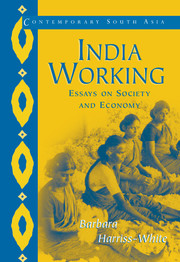Book contents
- Frontmatter
- Contents
- Preface and acknowledgments
- List of maps, figures and tables
- Glossary
- Abbreviations
- 1 Introduction: the character of the Indian economy
- 2 The workforce and its social structures
- 3 Indian development and the intermediate classes
- 4 The local State and the informal economy
- 5 Gender, family businesses and business families
- 6 India's religious pluralism and its implications for the economy
- 7 Caste and corporatist capitalism
- 8 Space and synergy
- 9 How India works
- 10 Postscript: proto-fascist politics and the economy
- Appendix 1 Liberalisation and Hindu fundamentalism
- Appendix 2 Relations between the developmental State and the intermediate classes
- Appendix 3 Roles of religious minorities in the Indian economy
- References
- Index of names
- Index of places
- Index of subjects
8 - Space and synergy
Published online by Cambridge University Press: 06 July 2010
- Frontmatter
- Contents
- Preface and acknowledgments
- List of maps, figures and tables
- Glossary
- Abbreviations
- 1 Introduction: the character of the Indian economy
- 2 The workforce and its social structures
- 3 Indian development and the intermediate classes
- 4 The local State and the informal economy
- 5 Gender, family businesses and business families
- 6 India's religious pluralism and its implications for the economy
- 7 Caste and corporatist capitalism
- 8 Space and synergy
- 9 How India works
- 10 Postscript: proto-fascist politics and the economy
- Appendix 1 Liberalisation and Hindu fundamentalism
- Appendix 2 Relations between the developmental State and the intermediate classes
- Appendix 3 Roles of religious minorities in the Indian economy
- References
- Index of names
- Index of places
- Index of subjects
Summary
We have to avoid the alternative of speaking either of space, locality and territory or of lineage, descent etc. The question is of losing sight of neither and of specifying more precisely their relation
(Dumont 1964, in Lambert 1996, p. 76).Economic activity is conducted in specific places, and the spatial patterns this activity makes – the sites, the routines, flows and interactions – also condition the results. So space is also one of the social structures of accumulation, although it has never been considered as such.
Here we will ask what is distinctive about the spatial character of the Indian economy, and what effects this has on capital accumulation. Examples will be drawn mainly (though not exclusively) from the south, focusing on Tamil Nadu, because this State has a rich literature that exemplifies the points I wish to raise. While nowhere is typical of ‘all-India’, the south Indian material helps us understand the ways in which social and spatial relations of accumulation manifest themselves unevenly throughout the subcontinent.
Given that some 88 per cent of India's population live in settlements of under 200 000 (see Table 1.1 and Figure 1.1), and that the concentration of capital in local towns is so vast, compared with rural areas, it is India's smaller towns and their regions that are the key arenas for the study of accumulation. Yet India is poorly urbanised, and its rate of urbanisation is actually slowing down, some regions being almost completely stagnant.
- Type
- Chapter
- Information
- India WorkingEssays on Society and Economy, pp. 200 - 238Publisher: Cambridge University PressPrint publication year: 2002



